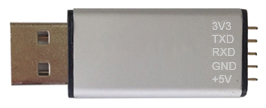
Build your Own Programming Cable
Leixen VV-808 / VV898 (S) (E)
by John 'Miklor'
K3NXU
A simple project with great results.
The heart of the project is a $2
CP2102 USB to TTL UART board. |
|
|
Let's See...
You purchased a
Leixen Mobile and now your ready to start programming it
using software. You now need to make a simple
choice. Buy or Build. Here's a simple project that will
not only save you a few dollars, but give you the
satisfaction of building it yourself.
You've probably heard the horror stories of the cables
with the 'counterfeit' chips that require backdated
drivers, but that doesn't apply here. The solution is to
start using a USB to TTL UART board with a CP2102 SiLabs chip. These boards are available on
eBay for around
$2.
Component list consists of
either:
or |
- CP2102 USB UART Board
- 3' piece of 3 conductor wire
- RJ-45 modular plug (8 pin)
Tools required:
- RJ45 Modular Plug Crimp tool
- Soldering pencil |
- CP2102 USB UART Board
- 3' Cat-5 Network Patch Cable
with 8 pin RJ-45 modular plug
Tools required:
- Soldering pencil
|
The Project
Let's first take a look at a typical CP2102 board. It's
pretty straight forward. USB on one end, a few
connection points on the other.
The output terminals we are interested in are:
TXD - Transmit Data
RXD - Receive Data
GND - Ground
Note 1: (Connection Pins)
Most boards have pins on the back requiring small connectors. You can either remove the pins or solder to them. Whatever floats your boat. I personally prefer removing the pins and soldering directly to the board.
Now it's just a matter of connecting to the proper pins
in the RJ45 plug.
The diagram below shows the required pin positions. Pin 6 is always the Ground connection.
Note 2:
(Labels Reversed)
Some boards may have the TxD and RxD labeled in reverse. If it doesn't work the first time,
don't panic. Just reverse the two wires on the CP2102
board. No damage has been done.
Cat-5 Network Patch Cable
If you don't have the connector or a crimping tool,
another possibility is to acquire a standard 3' Cat-5
network patch cable, and remove the connector from one end.
(or as Eric, G1SLP did, buy a 6' cable, cut it in half
and make two).
Trace the wires by color and continuity from pins 2, 5,
6 of the RJ-45 plug, and connect them to the
appropriate pins on the CP2102 board.
If you use the CP2102 in the metal case shown below, you
can solder directly to the pins.
Driver
When you insert the new board into the USB port, give
Windows a chance to find and load the new driver. This
should take about 30 seconds. When it says Driver Found,
you're done.
If Windows is setup to block automatic updates, SiLabs
drivers can be found at
SiLabs. All drivers seem to
work fine.
That's it...
Three wires from the board, three
wires to the connector. The key is knowing proper pin
assignment.
Now, let's say you want to get fancy. Maybe you have an
old programming cable in the drawer that doesn't work,
but like most hobbyists, you just couldn't bring
yourself to throw it away. Or, maybe to make it
cosmetically pleasing, you decide to buy one of the $3 specials,
just to have the USB case and wire. Here's how you would
mount it.
Let's start with that original cable.
Take a small screw driver and carefully pry the case open from
the back where the cable enters. Once the back is
opened, pry the case open evenly around the sides.
It should only be snapped together.
Unsolder the 3 wires connected to the old board.
GND is Black, TxD is Red, RxD is White or Yellow.
Clip off the old connector and insert the wires in the
RJ45 shown above.
Retrofit
Due to the slightly larger size,
the board shown above
may require a Dremel tool, X-Acto knife, Glue, and some
patience, but it can be done.
For a dollar more,
I very highly recommend using the 5 pin CP2102 board shown below. It
still has the needed GND, TxD and RxD, but is a bit shorter,
narrower, and fits with no issue. It may
cost a few pennies more, but well worth it.
Some come protected with a piece of clear heat shrink over the board so you can see the cool blinking lights.
This plastic can easily be removed.
You can find the same boards in
a
metal case.


Inside the metal housing.
Look familiar?
|
What's the Advantage
- First and Foremost, it works. Now you can program
using software.
- Next, it only cost around $2. Add $3 for a cable and case
- Very Important - Bragging Rights. Now, when you go to a
club meeting and tell them they can build their own, just as you
did.
I hope you had fun with this project. It's super simple
and very rewarding. I've made several and never had a
failure.
|
|
|
|
|